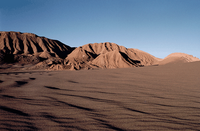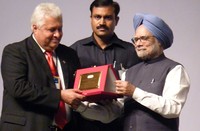 The Atacama desert is a 1,500-kilometre-long wedge of land that stretches along the Pacific coast from southern Peru to northern Chile. It receives, on average, just one millimetre of rainfall each year – a level of precipitation that is equivalent in thickness to a coin. Some weather stations in the area have yet to receive any rainfall.
The Atacama desert is a 1,500-kilometre-long wedge of land that stretches along the Pacific coast from southern Peru to northern Chile. It receives, on average, just one millimetre of rainfall each year – a level of precipitation that is equivalent in thickness to a coin. Some weather stations in the area have yet to receive any rainfall.
"Miniscule amounts of water have turned Atacama into a barren, lifeless landscape," says Rafael Navarro-González, a research professor and head of the Laboratory of Plasma Chemistry and Planetary Studies at the Institute of Nuclear Research at the National Autonomous University of Mexico. "In terms of its environment and ecosystem, it is the closest place to Mars on Earth."
 Navarro-González spoke about Atacama's role as a "scientific stage set" for Mars at the TWAS 21st General Meeting in Hyderabad, India, where he was awarded the 2009 TWAS prize in earth sciences.
Navarro-González spoke about Atacama's role as a "scientific stage set" for Mars at the TWAS 21st General Meeting in Hyderabad, India, where he was awarded the 2009 TWAS prize in earth sciences.
The story begins with the twin Viking voyages to Mars undertaken by the US National Aeronautic and Space Administration (NASA) in the mid 1970s. "The missions," says Navarro-González, "were designed to collect images and soil samples from the surface of Mars for evidence of life in the past."
"NASA scientists," Navarro-González continues, "conducted experiments on the samples, seeking evidence of life revealed by the presence of photosynthesis, gas exchange, and the degradation of organic compounds in the soil.
"Proof of any of these processes," says Navarro-González, "would indicate that Mars was not lifeless."
"The initial investigations," Navarro-González notes, "achieved positive results. Yet, each of the findings hinted that living organisms may not have been responsible for these seemingly biological reactions.
For example, photosynthesis was taking place in darkness – something that could not happen among living organisms. Photosynthesis requires sunlight. In fact, 'photo' in Greek means light.
Gas exchanges of oxygen were also detected, notes Navarro-González. When water was added to the Martian soil, scientists detected a sharp rise in oxygen levels. But additional applications of water resulted in no further release of oxygen. Based on previous experiments with soil from other ecosystems, they had anticipated a slow upward rise in oxygen levels as the water was absorbed into the soil.
Laboratory analysis of possible soil degradation, moreover, showed that the "broth" of molecules in the soil was being consumed in a form that may have mimicked biological activity but in truth was due to chemical reactions.
The final and most important test, Navarro-González says, confirmed the suspicions of the researchers: "In their direct search for organics in the soil, they found none."
Absent the presence of organisms, the scientists decided that chemical reactions, not biological activities, accounted for the "appearance" of biological-like activity on Mars.
"The previous experiments," says Navarro-González, "had produced false positives."
 And that's how the matter stood for more than a decade until scientists, in the 1980s, discovered rocks on Earth that they believed had originated on Mars. Extensive chemical analysis showed that the rocks had the same chemical composition and similar minerals to those found in the rocks analysed on Mars a decade earlier.
And that's how the matter stood for more than a decade until scientists, in the 1980s, discovered rocks on Earth that they believed had originated on Mars. Extensive chemical analysis showed that the rocks had the same chemical composition and similar minerals to those found in the rocks analysed on Mars a decade earlier.
These findings, Navarro-González says, rekindled a new round of public interest in Mars. "There were even calls for a return to Mars," notes Navarro-González. "But a new mission would cost billions of dollars and take years, if not decades, to launch."
So, researchers did the next best thing. They decided to conduct experiments on soil and rock samples taken from the desert lands of Atacama, which, compared to Mars, was next-door to their laboratories. Working with NASA, Navarro-González and his colleagues replicated the experiments of the 1970s "with, in a sense, the Earth's very own Mars samples."
This time, however, they deliberately laced the soil with perchlorate, an extremely oxidized, indeed explosive, salt. The use of perchlorate sparked a reaction that vaporized the soil, turning its trace elements of carbon dioxide into chloromethane and dichloromethane.
"These same hydrocarbons," says Navarro-González, "had been detected in the experiments done on soil samples from the Viking mission." But researchers had dismissed the findings believing that they were contaminants from cleaning fluids used to remove organics from the instruments at NASA's laboratories. "The contaminants were thought to have been released when the Viking Lander touched down on Mars and heated the soil," he explains.
"Our findings" – which will soon be published in the Journal of Geophysical Research – "clearly show that organics are present on Mars and that scientists working on soil samples from the Viking mission had simply misinterpreted the results." Mars, according to Navarro-González, has organics at levels 1,000 times higher than previously thought.
"Life's biological building blocks can indeed be found on Mars," concludes Navarro-González. "But whether life ever existed on the planet is still an open question." For that, we may, in fact, have to return to Mars. But, thanks to recent investigations in the Atacama, we have reason to believe that the next expedition won't necessarily be returning to Earth disappointed.

